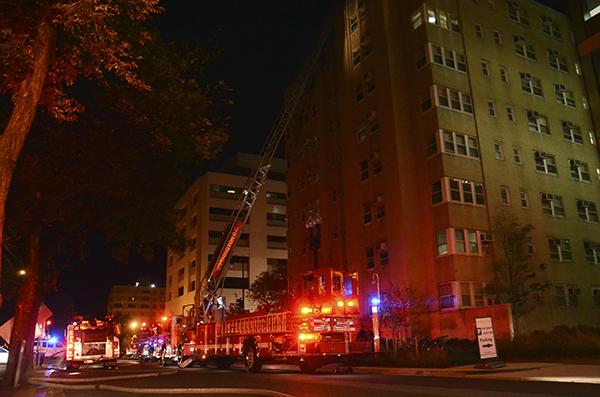A string of potentially dangerous situations on campus last week mobilized emergency response teams to evacuate three separate residence halls, shining a spotlight on the protocol of GW’s emergency readiness.
Though different schools employ different strategies, responders from GW are tasked with entering buildings to physically alert students who may still be inside their rooms during an emergency situation.
An early morning fire in Fulbright
That strategy was put into use early Tuesday morning during a roof fire at Fulbright Hall. The Metropolitan Police Department evacuated the building and D.C. Fire and EMS responded. Responders then ushered the residents into the Marvin Center.
After the fire last week, Senior Associate Vice President for Safety and Security Darrell Darnell said the roof of Fulbright Hall will be closed until further notice. He said the fire department is investigating the cause of the fire which “will help us to determine if adjustments need to be made to other rooftop decks.”
Munson Hall was also evacuated Saturday after reports of burnt food in an oven, which caused emergency responders to break a window to let the smoke out. At around 2:30 a.m. last Wednesday, 2109 F Street was evacuated from a gas smell due to an oven left on.
When students were told to leave Fulbright during the roof fire, their resident advisers were key in communicating with them about the investigation’s progress, two students said.
Sophomore Elizabeth Hasier, who lives on the building’s third floor, said the advisers would periodically check in on the groups of students while they were waiting in the Marvin Center, providing updates on the fire and ensuring the students they were in touch with the D.C. agencies.
“They were the most helpful,” Hasier said. “They honestly seemed very calm about it.”
Sophomore Margot Alpert, who also lives on the third floor of Fulbright, said the resident advisers were the ones directing the students into the Marvin Center. She called the process “effective” and “organized.”
“Everything ran pretty smoothly,” Alpert said. “There were no injuries, that should speak to that.”
GW’s procedure
When a fire alarm is activated in a campus building, University Police Department officers analyze the pulled alarm to confirm that it was not accidentally pulled or was a false alarm before they contact the Metropolitan Police Department or D.C. Fire and EMS, Darnell said in an email.
He said that if the officers call in city agencies, UPD “continues to be involved” with the response, but that MPD and D.C. Fire and EMS would become the “lead agency for the duration of the incident.”
Darnell also said that if UPD does not believe that everyone in the building heard the alarm and evacuated the building in a “quick and timely manner,” the officers knock on doors and yell in the hallways “to the extent possible, and making sure not to endanger themselves or others.”
Darnell said that the University encourages students to create their own plan for preparing for an emergency. The school will also be holding a GW Safety and Security Expo this week in University Yard, which includes safety demonstrations, the chance to build an emergency preparedness kit and other safety information.
“We thank the residents of Fulbright Hall for their cooperation in an unknown situation,” Darnell said.
Experts’ opinions
Randy Hormann, the president and CEO of the Fire Code Academy, which performs consultations and fire safety training at schools, said counting students from an evacuated building may not be effective in keeping track of them all. Emergency responders have no way of telling if the people not counted had been somewhere else when the alarm went off, he said.
“Numbers won’t do any good,” he said.
Hormann said one way that campuses can effectively empty buildings is by grouping together students whose rooms are near each other so they can communicate if someone they thought was in the building did not make it out. If a resident was sick and may not have heard the alarm, he said this strategy would give the neighboring residents a chance to tell responders they believe someone might not have heard the alarm.
“There should be a plan in place to have accountability,” Hormann said. “Try educating them on why we put them in a group based on their location in the building, so that way we know who’s there.”
Hormann added that a university may be held liable if they expect residents or resident advisers to check each room to make sure all the residents on their floor make it out of the building in an emergency.
“When someone has another role other than leaving the building, that puts them into a role of an emergency responder,” he said. “That opens up some potential liability.”
Robert Rowe, the president of the fire safety consulting firm Pyrocop, Inc., said besides having a smoke detector and sprinkler system, the most important factor for building safety is whether there is a staff member responsible for the safety of the people inside.
He described that person’s role as similar to GW’s resident advisers. A staff member should meet with students to make emergency plans and should know students well enough to tell if someone is missing from the group.
“With regard to emergency procedures, there still should be some staff put in place to account for the people in the building,” Rowe said.







